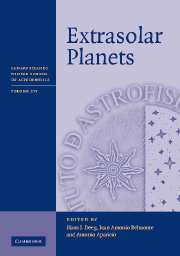Book contents
- Frontmatter
- Contents
- List of contributors
- List of participants
- Preface
- Acknowledgements
- 1 Overview of extrasolar planet detection methods
- 2 Statistical properties of exoplanets
- 3 Characterizing extrasolar planets
- 4 From clouds to planet systems: formation and evolution of stars and planets
- 5 Abundances in stars with planetary systems
- 6 Brown dwarfs: the bridge between stars and planets
- 7 The perspective: a panorama of the Solar System
- 8 Habitable planets around the Sun and other stars
- 9 Biomarkers of extrasolar planets and their observability
- References
1 - Overview of extrasolar planet detection methods
Published online by Cambridge University Press: 10 August 2009
- Frontmatter
- Contents
- List of contributors
- List of participants
- Preface
- Acknowledgements
- 1 Overview of extrasolar planet detection methods
- 2 Statistical properties of exoplanets
- 3 Characterizing extrasolar planets
- 4 From clouds to planet systems: formation and evolution of stars and planets
- 5 Abundances in stars with planetary systems
- 6 Brown dwarfs: the bridge between stars and planets
- 7 The perspective: a panorama of the Solar System
- 8 Habitable planets around the Sun and other stars
- 9 Biomarkers of extrasolar planets and their observability
- References
Summary
In this chapter we will describe in a general manner each planet detection method and examine the fundamental astrophysical parameters each technique measures as well as its present measurement limitations for the detection of inner giant planets, jovian outer planets, and Earthlike planets. We then outline several secondary detection methods that may be instituted in the near future with increased detection sensitivity. We then discuss the ranges of each detection method and sketch several cases in which additional parameters may be derived through the acquisition of data from several methods combined. In the final section we discuss habitable zones around M-dwarf systems as potential near-term targets for the detection of life-supporting planets.
Introduction
In the following sections an overview of the main methods of extrasolar planet detection is presented. This is not a historical review – an excellent review, for example, can be found in Perryman (2000) and the 469 references therein. It is also not an up-to-date listing of extrasolar planet detections or candidates; these can be found at the comprehensive site of the Extrasolar Planets Encyclopedia by J. Schneider (www.obspm.fr/encycl/encycl.html). In this chapter we do, however, describe in a general manner each detection method and examine the general astrophysical parameters each technique measures as well as its present measurement limitations. We mention some secondary detection methods that may find application in the near future and what additional parameters may be derived through the acquisition of data from several methods combined.
- Type
- Chapter
- Information
- Extrasolar Planets , pp. 1 - 23Publisher: Cambridge University PressPrint publication year: 2007
References
- 1
- Cited by



